Learning to drive a manual car
Most people find learning to drive a manual car is much harder than an automatic car especially when they need to do a parallel park or drive uphill. Students often fail in these two skills in the driving test. There is a necessity to master these skills not only for the test but also to drive better in your life. Here is the step by step on how to drive a manual car and tips to handle all kind of circumstances in a manual car.
Understand a manual transmission car
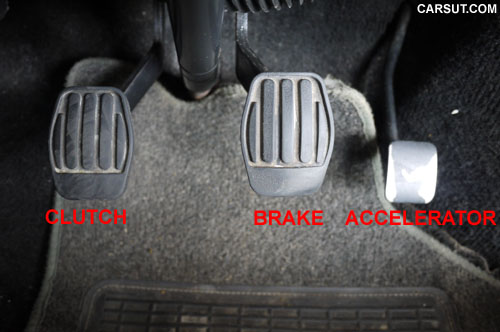
A manual transmission car has three pedals: on the right is the gas pedal/accelerator, on the left is the clutch pedal, and in the middle is the brake pedal. A clutch is a doorway to shift the gear. No gear can be shifted if the clutch is not applied. Whether it is LHD (Left-Hand-Drive) or RHD (Right-Hand-Drive), you will see these three pedals. For LHD car, you will use your right hand to shift the gear and the other way round for RHD car.
Study the Stick Shift
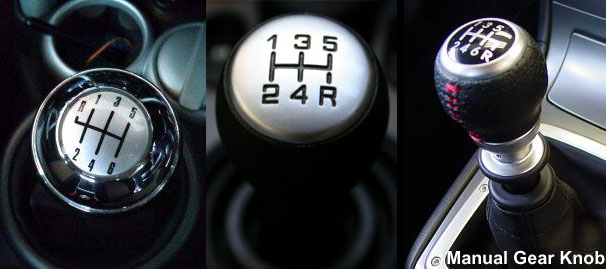
Most of the manual cars running on the road today are five-speed. Some manual cars like the Honda CR-Z have six-speed while some earlier type has only four-speed. Before driving the car, sit on the driver’s seat, use your left foot to press the clutch to the floor and try to shift every gear to familiarise with it. The numbers indicate the gear and the “R” means reverse gear. Check if your gear knob has a button that locks the reverse gear. Some cars like the Renault Kangoo comes with a lock where you need to press/pull a button to shift the gear into reverse. Once you are familiar with the shifting, make sure you shift it back to neutral (in the middle where you don’t feel the stiffness in the gear stick) before starting the car.

Step by step to drive a manual car
Step 1: Adjust the driver’s seat to a position where you can fully step down the clutch pedal with your left foot. Your body will move back a little bit when you drive up hill. Therefore, do not slight the seat too far or too close from the pedals.
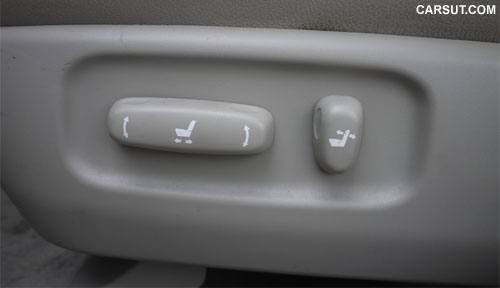
Step 2: Make sure the gear is shifted to neutral and the handbrake (e-brake) is engaged. Use your right foot to step on the brake and start the car. For better practice, you may also press the clutch with your left foot every time you start the car to avoid the car going forward if the gear is engaged without your knowing.
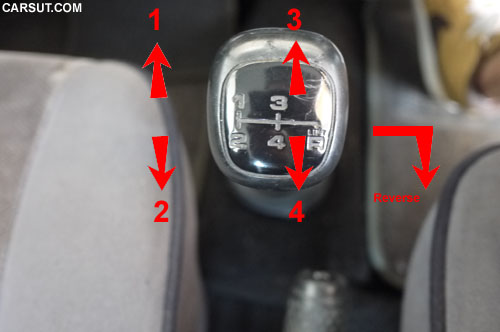
Step 3: Press the clutch all the way down to the floor and shift the gear to first (1) gear. Look around to see if there are any vehicles coming. If it is safe to take off, release the handbrake.

Step 4: Release the clutch gently and step on the gas pedal lightly simultaneously. Give more gas to the car or hold the clutch if the engine sounds like it is going to stall. Move your left foot to the foot rest area when the car moves forward.


Step more on the gas pedal/accelerator to go faster
Step 5: Change gear. An experienced driver knows when to change the gear by listening to the engine sound. A good way for beginners is to look at the RPM gauge. Shift the gear when it reaches about 3000 to 4000 rpm. To shift to second gear, lift the right foot from the gas pedal, press the clutch pedal all the way down and shift to second gear. Release the clutch gently and step on the gas pedal as in Step 4. The more you step on the gas pedal, the faster the car goes. Repeat the same process to shift to other gears.
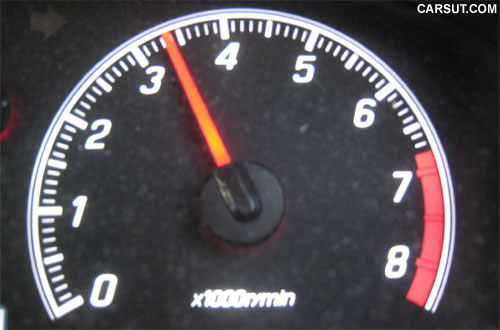
Step 6: Slow down and stop. Lift your right foot from the gas pedal, use the left foot to press the clutch, and then apply the brake to slow down the car or to stop the car. Once the car is stop, shift the gear to N (Neutral) and apply the handbrake.

Tips
Seating Position. Many people fail in the driving test during uphill because their left foot could not fully reach the clutch pedal. This is because the seat is too far from the pedals. Adjust it to a position where you are able to press the clutch all the way down the floor even your body is close to the seat.
Clutch Control: First gear is always the hardest. Control the clutch gently every time you release it. Gently here means slowly, gradually, or bit by bit. Many first time learners lift their left foot immediately and cause the car engine to stall. Step hard on the brake and the clutch, and pull the handbrake to stop the car in case of emergency.
Reverse: Many people make mistakes by shifting the gear to reverse while the car is still moving forward. Wait until the car stopped completely and then only shift to reverse gear.
Stop at traffic: Shift the gear to neutral and apply the handbrake every time you stop at traffic. This is to secure the car from being jerk forward if you are hit from behind.
Going uphill: If you are going uphill and need to stop the car on the slope, shift to neutral and apply the handbrake. To continue the journey, step on the clutch, shift to first gear, and give more gas (step harder on the accelerator) with your right foot. Release the handbrake when you feel it is powerful enough to move forward. More gas (But not too much) is needed because the car is in a sloping position.
Going downhill: Shift to lower gear for downhill driving to increase the engine braking effect.
Most drivers experienced engine stall while they learn how to drive a manual car. Practice makes perfect. The more you practise, the better your driving skill will be.